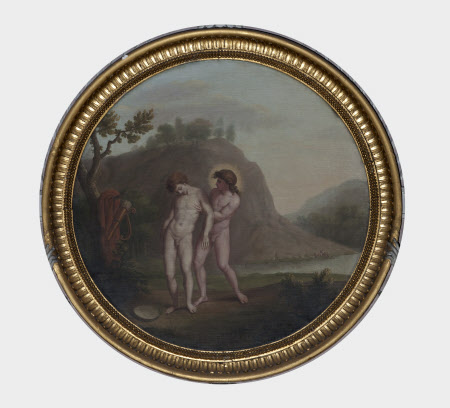Apollo and Hyacinthus (after Domenichino)
William Hamilton RA (Chelsea 1751 - London 1801)
Category
Art / Oil paintings
Date
circa 1768 - 1771 (recorded)
Materials
Oil on canvas (circular)
Measurements
750 mm (Diameter)
Place of origin
England
Order this imageCollection
Kedleston Hall, Derbyshire
NT 108797
Caption
The circular paintings framed in plasterwork above the fireplaces represent Apollo and Hyacinthus (after Domenichino) (1581-1641), and Diana and Arethusa, after Hubert Gravelot (1699-1773): alluding respectively to the origin of flowers and waterfalls, and perhaps intended to celebrate the creation of the landscape at Kedleston, through which the visitor passes to reach the house. Hyacinthus was the Spartan prince loved by Apollo, but killed by a discus – hyacinth flowers sprouting from the place where his blood fell. Arethusa was rescued by Diana from Alpheus – but only at the cost of being turned into a stream. Both paintings are attributed to the artist William Hamilton (1751-1801), one of Adam’s Scottish proteges
Summary
Oil painting on canvas (circular), Apollo and Hyacinthus (after Domenichino) by William Hamilton RA (Chelsea 1751 – London 1801). Apollo, with nimbus (right) supports the dying Hyacinthus. The discus lies to left at Hyacinthus' feet a cloak and quiver of arrows hang on a tree to left. Both naked, standing centre in a landscape. Behind them runs a river, with cattle on the far bank, which is backed by a hill topped with trees, in the distance to the right is another hill behind more trees. One of two round oil paintings; pair with Diana and Arethusa, after Gravelot, The Marble Hall, Kedleston, KED/P/62. Hyacinthus was the son of Amyclas, king of Sparta and Diomede, he was a beautiful youth and the gods Zephyrus the West Wind and Apollo both fell in love with him. Hyacinthus favoured Apollo and Zephyrus in a fit of jealousy deflected a discus which Apollo was throwing to Hyacinthus. The discus hit and killed Hyacinthus. Grief-stricken Apollo transformed his lover’s mortal blood into a dark blue flower, the ‘hyacinth’ and thus made him immortal. The flower was born again each spring and on its petals can be read ‘ai ai’ (‘alas’) which is the cry of grief made by Apollo on the death of his lover. Hyacinthus was worshipped every year at Sparta during the festival of the Hyacinthia. The circular paintings framed in plasterwork above the fireplaces represent Apollo and Hyacinthus after Domenichino (1581-1641), and Diana and Arethusa after Hubert Gravelot 1699-1773): alluding respectively to the origin of flowers and waterfalls, and perhaps intended to celebrate the creation of the landscape at Kedleston, though which the visitor passes to reach the house. Hyacinthus was the Spartan prince loved by Apollo, but killed by a discus – hyacinth flowers sprouting from the place where his blood fell. Arethusa was rescued by Diana from Alpheus – but only at the cost of being turned into a stream. Both paintings are attributed to the artist William Hamilton (1751-1801), one of Adam’s Scottish protégés.
Provenance
Recorded over chimneypieces in Hall in 1771; and by descent until purchased in 1987 by the National Trust from Francis Curzon, 3rd Viscount Scarsdale (1924-2000).
Credit line
Kedleston Hall, The Scarsdale Collection (acquired with the help of the National Heritage Memorial Fund and transferred to The National Trust in 1987)
Marks and inscriptions
n
Makers and roles
William Hamilton RA (Chelsea 1751 - London 1801), artist
